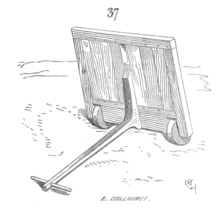Pluteus (protective wall)
The pluteus ( Latin , plural plutei ; also pluteum ) was a mobile, wooden protective wall that was used by archers in ancient and medieval times during siege attacks.
Description and use
This protective wall was made of wood or woven branches. It stood on two or three wheels, which meant that it could be pushed. There were small openings in the wall itself through which the archers could shoot their arrows. It served as protection from enemy projectiles and was used during sieges. They could be moved during the battle and thus approached within the range of the defenders, protected. Quivers were sometimes attached to the inside of the plute, so the archers had enough ammunition. The wall was mostly straight, in later-built specimens, two walls enclosed an obtuse angle, which also provided protection on the sides. Sometimes light ballistae were also protected by a pluteus.
history
Roman legion
In the Roman Legion many such protective walls were used for a siege, mostly on the flanks of the fortress, while the heavier siege equipment was rolled up in the middle. The only task of the archers with the plutei was to bombard the defenders and thereby prevent them from attacking the large siege equipment. For this purpose, plutei were used, which were rammed into the earth (see illustration).
literature
- Peter Connolly : Life at the time of Jesus of Nazareth . Tessloff, 1984, ISBN 978-3788605360


